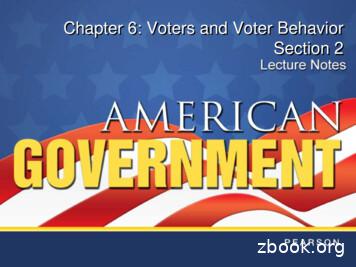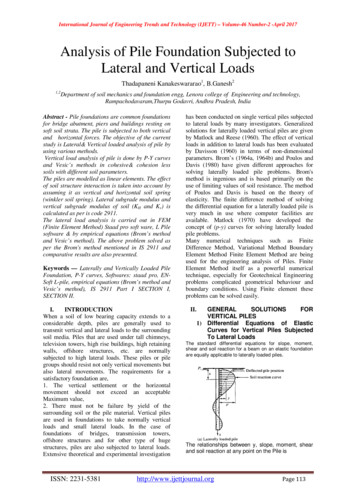Voters And Voter Behavior
Voters and Voter BehaviorChapter 6
Section 4VOTER BEHAVIOR
Nonvoting The word idiot comes from the Greek idiotes –citizens who do not vote or participate in publiclife.– 2008 there were appx 228 million eligible voters andonly 131 (60%) participants.– Voters tend to turn out in smaller number for off-yearelections. (national elections for congress in which apresidential seat is not open for election) Ballot fatigue – the lower the level of office, the lower levelof voter participation nonvoting voters – are those who choose to cast a ballot forsome officials and not cast a ballot for others.
Why People Do Not Vote Cannot-Voters – Included in the number of nonvoters some people who cannot cast a ballot.––––––Resident aliens (10 million)Ill or physically disabled (5-6 million)Unexpectedly traveling for work or family (2-3 million)Mental health facility patients (.5 million)Incarcerated individuals (2 million)Religious adherents who’s religion forbids voting (.1million)– Racial or religious discrimination through 1. thepurposeful administration of election laws or 2. localpressures that prevent people from voting.
Actual Nonvoters This still leaves 80 million American voters whowere eligible to cast ballots who did not.– People who are largely pleased with government nomatter who is in office– People who are largely dissatisfied with governmentno matter who is in office.– People with little political efficacy – who don’t thinktheir vote has an impact.– Inconvenience of election requirements and processes– Voter indifference
Voters v NonvotersVoters Voters tend to have higherlevels of income, education,and occupational status. Tend to be long timeresidents Tend to have strong partyidentification Likely to live in areas wherelaws, customs, andcompetition promoteturnout.Nonvoters Younger than 35,unmarried, and unskilled. Tend to be from the southor rural areas. People with low politicalefficacy.
Voters and Voting Behavior Three sources of info about voter behavior– Election results– Survey research– Studies of political socialization (the process by whichpeople gain their political attitudes and opinions) Social factors– Voters’ personal characteristics (age, race, income,occupation, education, religion, etc)– Voters’ group affiliations (family, friends, co-workers) Psychological factors– Perceptions of politics, issues, candidates
Sociological Factors Income and Occupation– Lower income tend to vote Democratic; High incometend to vote Republican– Professional and business people tend to voteRepublican; laborers tend to vote Democratic. Education– Higher education levels tend to favor Republicansexcept for among post-baccalaureate degree holders. Gender, Age– Women generally favor Democrats, studies show thisis reversed amongst many married, white women.– Young voters tend to vote for Democrats.
Sociological Factors cont Religion, Ethnic Background– Protestants tend to vote for the Republican candidate; Catholicsand Jews tend to support Democrats.– African Americans vote for Democrats in overwhelmingmajorities; Native Americans and Latinos tend to supportDemocrats also. Geography– Southerners vote for Republicans– Urban areas tend to favor Democrats; Suburban areas tend tofavor Republicans; Rural areas tend to favor Republicans. Family and other Groups– 90% of married couples vote in the same ways– 2/3 of voters follow the political leanings of their parents.– Groups of friends tend to favor similar political views.
Question? How would a 55 year old African Americanwith a bachelor’s degree who is a member ofthe AFL-CIO vote?
Psychological Factors Party Identification– Voters tend to identify with a particular party early inlife and then continue to support that party and itscandidates throughout their life.– Voting for candidates of only one party is known asstraight-ticket voting. Split-ticket voting – voting for candidates of more than oneparty is increasing. Perhaps due to the large number of independent voters. Candidates and Issues– Candidates and their ability to attract voters as well asimportant national issues impact voting behavior.
Voters and Voter Behavior Chapter 6 . VOTER BEHAVIOR Section 4 . Nonvoting The word idiot comes from the Greek idiotes – citizens who do not vote or participate in public life. –2008 there were appx 228 million eligible
C H A P T E R 6 Voters and Voter Behavior C H A P T E R 6 Voters and Voter Behavior SECTION 1 The Right to Vote SECTION 2 Voter Qualifications SECTION 3 Suffrage and Civil Rights SECTION 4 Voter Behavior S E C T I O N 1 The Right to Vote How h
r 6 Voters and Voter Behavior Why do voters act as they do? A. Think about all the steps that might be involved with casting a ballot in an election. What steps must a voter take in order to carry out this task responsibly? Identify as many steps as
Nov 08, 2016 · Poll TrumpClintonOtherUndecided Spread Insights West Nov 4 – Nov 7 940 Likely Voters 41 45 2 8 Clinton 4 Likely Voters - Democrat 6 89 0 4 Clinton 83 Likely Voters - Republican 82 7 2 6 Trump 75 Likely Voters - independent 38 43 4 7 Clinton 5 IBD/TIPP Nov 4 – Nov 7 1,107 Likely Voters 43 41 4 5 Trump 2 1,107 Likely Voters 42 43 5 9 .
registration: a method of voter identification intended to prevent fraud purging: the process of removing the names of voters who are no longer eligible to vote poll books: the official lists of qualified voters in each
I am delighted about this Voter Education Curriculum whose development has been informed by the need to enhance voter education in Kenya. Effective voter education raises awareness among voters thereby enhancing their participation in the electoral process. Therefore, adherence to this curriculum shall lead to effective
Women of color voters are mobilizing a powerful, motivated, and Democratic voting bloc. 1-in-10 women of color voters were first-time voters –of those first-time voters, almost all are sure they will vote in the next election. Women of color voters largely went blue across races–Black w
o CHAPTER 6 ::5 Voters and Voter Behavior ''It is not enough that people have the right to vote . . People must have the reason to vote as well. '' -Jesse Jackson (1988) People who have struggled to win the right to vote know how important it is. Although, since 1789, suffrage has expanded to include many more people-notably African Americans and
Weight of pile above scour level Wp1 220.893 kN Weight of pile below scour level Wp2 301.548 kN Tota l ultimate resistance of pile Qsf Qb – Wp2 8717.452 kN Allowable load (8717.452 / F.S.) – Wp1 3266 kN. From above calculations, Required depth 26.03m below design seabed level E.G.L. ( ) 1.15 m CD . International Journal of Engineering Trends and Technology (IJETT) – Volume .























